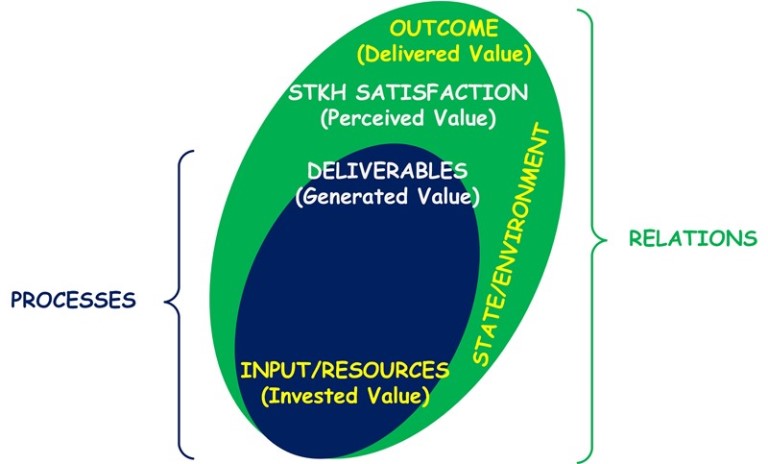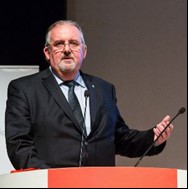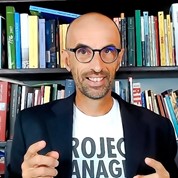to Manage Effectively the Complex
Projects, Programs, and Portfolios
FEATURED PAPER
By Marco Caressa and Massimo Pirozzi
Italy
ABSTRACT
In the last ten years, the evident rise of the complexity in both the projects and the programs has been compensated just partially by the increase of the organizations’ maturity in project management, and this is reflected in the field data, which confirm very little improvements in projects’ performances. This paper explores extensively the domain of complexity in the projects – as well as in their parts, e.g. the sub-projects, the phases, the account controls, the work packages, and as in the programs and the portfolios they are part of – both from a system and a pragmatic perspective, focuses on the foundational importance of the integration as a critical success factor, and proposes both an innovative approach to manage effectively the complex projects, programs, and portfolios, and an innovative model to assess effectively the relevant complexity levels.
THE PROJECT INTEGRATION: A CRITICAL SUCCESS FACTOR AND A CORE COMPETENCE
A system may be defined as “a regularly interacting or interdependent group of items forming a unified whole (Merriam Webster)”. In order to face the complexity, we generally break down a system in subsystems that are characterized by lower complexities, and this is typically done in accordance with a hierarchical structure. Each subsystem is characterized by its not only inputs, outputs, and states, but definitively also by its set of relations with the other subsystems and with the system itself, and it is the totality of the subsystems and of their relations that determine the performance of the system as a whole. Therefore, a system’s performance do not simply coincide with the sum of the performances of its subsystems, but is determined by the integral sum, i.e. the integration, of the subsystems, which integrates their performances and their relations.
Each project can be considered a nonlinear, open system, in which same inputs may generate, in different states and/or environment, different outputs, and in which diverse levels of complexity characterize the relations among scope, time, cost and quality. In project management, we make efforts to “linearize” projects by breaking them down in subprojects/phases up to work packages, by defining the precedence relations among their work packages/ activities, by making all those estimates that are needed to establish a common baseline, and we take into account the project complexity by properly managing – also in terms of modifications and/or corrective actions to be implemented – the deviations from the baseline that arise from adequate Key Performance Indicators, the principal of which is the Earned Value (indeed, Earned Value Management is specifically thought to recognize and to face the non-linear relations among the cost, the time, and the work performed).
In addition, since all projects are made by people for other people (Pirozzi, 2019), and the same principle is of course valid also for all subprojects and work packages, above structured, rational approach must be integrated with a structured, relational approach that can manage properly the interactions among stakeholders, which occur in the form of communications – therefore, it is not so surprising that the project managers spend almost 90% of their time in communicating! –, the effectiveness of which can be continuously tested via measuring other specific Key Performance Indicators, as e.g. the stakeholder satisfaction and the project perceived value (Pirozzi, 2021) KPIs.
A systemic view (Fig.1) – valid for the elements at the different levels of project breakdown, including the project, the subprojects, the phases, the control accounts, and the work packages – can be applied to the stakeholder perspective (Pirozzi, 2017), in order to highlight – visually too – the importance of the integration.

Fig.1 – A Systemic View of a Project
Indeed, for each project element, the outcome is the result of the integration of the processed inputs with the relations, i.e. the integration of the generated value due to the deliverables with the perceived value due to the stakeholder satisfaction. In each project element, the width of the “green” gap represents the incidence on the results due to the relations with respect to the “blue” incidence due to the processes, and corresponds also both to the level of systemic non linearity and, therefore, to the level of complexity, as we will see in the following. Definitively, the “green” domain corresponds to the integration work, which is a responsibility of the project manager, while the “blue” domain corresponds to a delivery work, the responsibility of which is of the team members/leaders who are entitled to realize the different work packages by respecting the given constraints…
More…
To read entire paper, click here
How to cite this paper: Caressa, M and Pirozzi, M (2021). An Innovative Integrated Approach to Manage Effectively the Complex Projects, Programs, and Portfolios; PM World Journal, Vol. XI, Issue I, January. Available online at https://pmworldlibrary.net/wp-content/uploads/2022/01/pmwj113-Jan2022-Pirozzi-Caressa-Innovative-Integrated-Approach-to-Manage-Effectively-Complex-Projects.pdf
About the Authors

Massimo Pirozzi
Rome, Italy
![]()
Massimo Pirozzi, MSc cum laude, Electronic Engineering, University of Rome “La Sapienza”, Principal Consultant, Project Manager, and Educator. He is a Member of the Executive Board and of the Scientific Committee, and an Accredited Master Teacher, of the Istituto Italiano di Project Management (Italian Institute of Project Management). He is certified as a Professional Project Manager, as an Information Security Management Systems Lead Auditor, and as an International Mediator. He is a Researcher, a Lecturer, and an Author about Stakeholder Management, Relationship Management, and Complex Projects Management, and his papers have been published in U.S.A., in Italy, and also in Russia; in particular, he is the Author of the innovative Book “The Stakeholder Perspective: Relationship Management to enhance Project value and Success”, CRC Press, Taylor & Francis Group, Boca Raton (FL), U.S.A., October 2019. Due to the acknowledgement of his comments on stakeholder-related issues contained in Exposure Draft of The Standard for Project Management – 7th Edition, he has been recognized as one of the Contributors and Reviewers of The PMBOK® Guide – Seventh Edition, and he received the Certificate of Appreciation for Excellence for his volunteer contributions to the Project Management Institute and the project management profession in 2020.
Massimo Pirozzi has a wide experience in managing large and complex projects, programs, and portfolios in national and international contexts, and in managing business relations with public and private organizations, including multinational companies, small and medium-sized enterprises, research institutes, and non-profit organizations. He worked successfully in several sectors, including Defense, Security, Health, Education, Engineering, Logistics, Cultural Heritage, Transport, Gaming, Services to Citizens, Consulting, and Web. He was also, for many years, a Top Manager in ICT Industry, and an Adjunct Professor in Organizational Psychology. He is registered as an Expert both of the European Commission, and of Italian Public Administrations.
Massimo Pirozzi is an Accomplished Author and an International Editorial Advisor of PM World Journal. He received three 2020 PM World Journal Editor’s Choice Awards for his featured paper “Project Management for Evidence Based Medicine” (co-authored with Dr. Lidia Strigari), for his Article “Project communications 1.0 and 2.0: from information to interactivity” and for his report from Italy titled “The fight against Coronavirus disease (COVID-19) from the perspectives of projects and of project management”. He received also two 2019 PM World Journal Editor’s Choice Awards for his featured paper “Stakeholders, Who Are They?”, and for his report from Italy titled “PM Expo® and PM Maturity Model ISIPM-Prado®”, and a 2018 PM World Journal Editor’s Choice Award for his featured paper “The Stakeholder Management Perspective to Increase the Success Rate of Complex Projects”.
Massimo can be contacted at max.pirozzi@gmail.com.

Marco Caressa
Rome, Italy
![]()
Marco Caressa, MSc cum laude, Nuclear Engineering, University of Rome “La Sapienza”, IT Manager, Project & Program Manager, Consultant and Trainer. He is certified as a Professional Project Manager according to the UNI 11648 and UNI 11506 Italian standards, compliant with the ISO 21500 “Guidance on Project Management”.
Marco Caressa has more than 25 years of experience in software coding and design, enterprise and digital systems architecture, big data, research and management for Engineering Ingegneria Informatica SpA. He has extensive experience in managing large and complex digital business transformation projects and programs.
Currently, he deals with supply engineering through the proposition of digital solutions and innovative technologies in different market areas, including Engineering, Public Sector, Industry, Insurance & Finance. PMP®, PMI-ACP® , PRINCE2 Practitioner, Scrum Master, enthusiast of traditional and agile Project Management. Blogger and columnist for trade and web magazine, trainer, mentor and coach. He is active on social networks, for 3 years with his LinkedIn page and for 1 year with a YouTube channel he has been working as a popularizer of managerial disciplines.
Marco Caressa has intervened in various training events, webinars (PMI, Project Management Institute; ISIPM, Istituto Italiano di Project Management) and as keynote speaker at conferences, including the last two editions of PMExpo, the largest Italian event on Project Management, organized and promoted by ISIPM (Istituto Italiano di Project Management).
Marco Caressa has collaborated as a professor of Project Management for several Italian universities, including:
– Master in Project Management (LUISS, Libera Università degli Studi Sociali di Roma)
– Second Level Master in Data Science (University of Perugia)
– Course of planning and management of European funds (University of Rome Tor Vergata)
– First level Master “Industry 4.0” (University of Pisa)
– First level Master “Scalability: digital technologies and company growth” (University of Pisa, Scuola Superiore S. Anna of Pisa)
Marco can be contacted at: marco.caressa@pm.me or through his LinkedIn page (https://www.linkedin.com/in/marcocaressa/) or his YouTube channel (https://www.youtube.com/c/MarcoCaressa)









